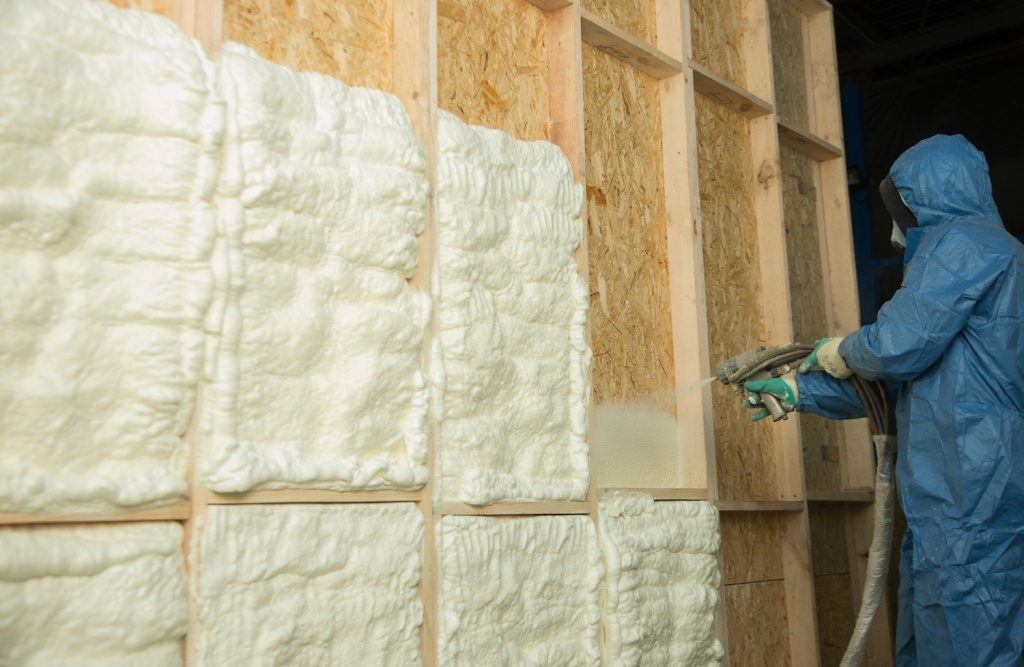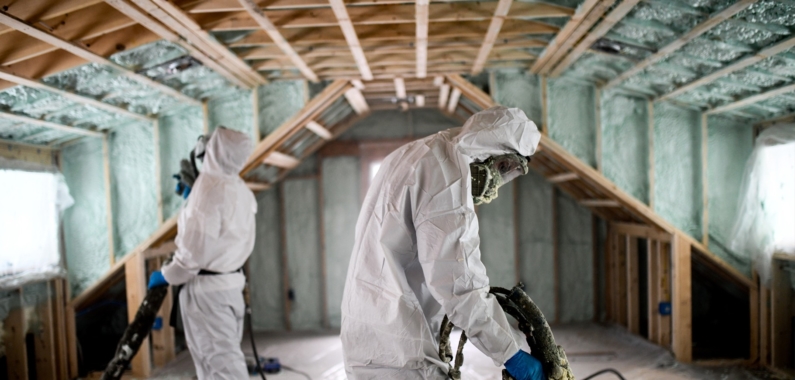Tips for Maintaining Your Spray Foam Insulation for Long-Term Performance
Tips for Maintaining Your Spray Foam Insulation for Long-Term Performance
Blog Article
Spray Foam: The Ultimate Option for Air Sealing and Insulation
Spray foam insulation has actually emerged as a leading remedy for effective air sealing and thermal insulation, offering an unique combination of residential or commercial properties that set it in addition to standard methods. Its capability to expand and fill voids makes it especially effective in protecting against air leakage, which can considerably impact energy performance. Nonetheless, recognizing the complete scope of its benefits, setup procedures, and comparisons with other insulation types is crucial for making informed choices. As we explore these aspects, the ramifications for both new buildings and retrofits end up being increasingly significant. What variables should affect your choice?
What Is Spray Foam?
Spray foam is a flexible insulation product that incorporates the principles of air sealing and thermal resistance to enhance power performance in structures. Made up mainly of polyurethane or other similar substances, spray foam is used as a liquid that increases upon call with surface areas, producing a strong, continuous layer of insulation. This distinct home enables it to fill up gaps, cracks, and spaces that standard insulation materials might ignore, giving a remarkable air seal.
There are 2 major kinds of spray foam: open-cell and closed-cell. Open-cell spray foam is lighter and a lot more adaptable, offering excellent sound absorption and a reduced R-value per inch - Spray Foam. On the other hand, closed-cell spray foam is denser, offering a greater R-value, moisture resistance, and included structural honesty to building elements
The application process typically includes specific devices, making certain a smooth application that follows different substrates, including metal, timber, and concrete. This flexibility makes spray foam suitable for both new constructions and retrofitting existing structures. Its capacity to produce an impermeable barrier significantly adds to lowering energy intake and boosting interior air quality, therefore making it a recommended selection among contractors and home owners alike.
Benefits of Spray Foam Insulation
One of the most considerable benefits of spray foam insulation is its phenomenal capability to produce a constant air obstacle, which successfully reduces energy loss. Unlike standard insulation products, spray foam broadens to fill splits and voids, making sure that air leakage is significantly minimized. This particular not only enhances power performance but also leads to decrease utility expenses gradually.
Furthermore, spray foam insulation offers premium thermal resistance, adding to a more steady indoor environment. Its high R-value per inch permits reliable insulation in constrained areas, making it suitable for attic rooms, walls, and crawl rooms. Additionally, the moisture-resistant residential or commercial properties of spray foam assistance prevent mold and mold development, promoting healthier living problems.
An additional critical advantage of spray foam insulation is its sound-dampening high qualities (Spray Foam). It effectively decreases sound transmission between rooms, producing a quieter and more comfortable home setting. The sturdiness of spray foam also sticks out, as it does not sag or work out with time, keeping its efficiency throughout its life expectancy
Just How Spray Foam Works
Comprehending how spray foam insulation functions is crucial for valuing its effectiveness in air sealing and thermal resistance. Spray foam insulation includes two key elements: isocyanate and polyol material. When these components are combined, they go through a chemical response that creates the material to expand quickly, developing a dense foam that fills tooth cavities, spaces, and splits.
As the foam increases, it sticks to surfaces, developing a closed seal that considerably lowers air seepage. This characteristic makes spray foam insulation highly reliable at stopping drafts and dampness infiltration, which can bring about power loss and damage gradually. In addition, the closed-cell variation of spray foam supplies remarkable thermal resistance as a result of its inflexible framework, effectively lessening warm transfer.
The distinct properties of spray foam enable it to comply with uneven surfaces, making certain detailed insurance coverage and a seamless barrier. Because of this, spray foam insulation not just boosts power effectiveness however likewise see page contributes to boosted indoor air top quality by minimizing the accumulation of toxins and irritants. Eventually, understanding the auto mechanics behind spray foam highlights its function as an exceptional choice for insulation and air sealing in both industrial and property applications.
Setup Refine Overview

Before installation, the space has to be properly cleaned and prepped, guaranteeing that surface areas are without dust, moisture, and debris. Due to the fact that contaminants can compromise bond and total performance, this step is important. When the location is prepared, the application includes blending both elements of the spray foam, which expands upon call and fills gaps properly.
Trained professionals must perform the setup, making use of specific equipment to guarantee consistent protection and ideal thickness. Security safety measures, consisting of putting on safety equipment and guaranteeing proper air flow, are crucial during this process. After application, the foam normally cures swiftly, forming a strong obstacle that enhances energy efficiency.
Comparing Spray Foam to Traditional Insulation
When reviewing insulation alternatives, spray foam insulation attracts attention in contrast to conventional products such as fiberglass and cellulose. Among the main advantages of spray foam is its exceptional air sealing abilities. Unlike fiberglass and cellulose, which can permit air infiltration, spray foam expands upon application, loading spaces and holes to develop a closed seal. This causes enhanced energy effectiveness, as less heated or cooled down air escapes the home, leading to lower energy expenses.
Additionally, spray foam offers a higher R-value per inch than typical insulation types, offering even more efficient thermal resistance in a thinner account. This characteristic is specifically advantageous precede with minimal dental caries depth. Spray foam is immune to dampness and mold development, which can be a significant worry with cellulose and fiberglass, specifically in moist settings.
Nonetheless, spray foam insulation generally lugs a greater ahead of time expense than its standard counterparts. House owners have to weigh this preliminary investment against lasting power savings and performance benefits. Ultimately, while both insulation kinds offer their objective, spray foam becomes an advanced option for contemporary insulation demands, especially in regards to air securing and thermal effectiveness.

Conclusion
In summary, spray foam insulation stands for a highly effective solution for attaining optimal air securing you could try these out and thermal resistance. Its distinct homes, including dampness resistance and sound dampening, make it appropriate for numerous applications in both new constructions and retrofitting jobs (Spray Foam). The initial expenses might be higher contrasted to conventional insulation materials, the long-term advantages, such my sources as significant power cost savings and improved interior air top quality, justify the investment and underscore its value in modern building practices.
Spray foam insulation has actually arised as a leading solution for effective air securing and thermal insulation, supplying a distinct mix of properties that establish it apart from standard methods.Spray foam is a flexible insulation product that combines the concepts of air securing and thermal resistance to boost power performance in structures.When examining insulation options, spray foam insulation stands out in comparison to traditional products such as fiberglass and cellulose. Eventually, while both insulation types serve their objective, spray foam emerges as an extra innovative solution for modern-day insulation needs, particularly in terms of air securing and thermal efficiency.
In summary, spray foam insulation represents a very reliable solution for accomplishing optimum air securing and thermal resistance.
Report this page